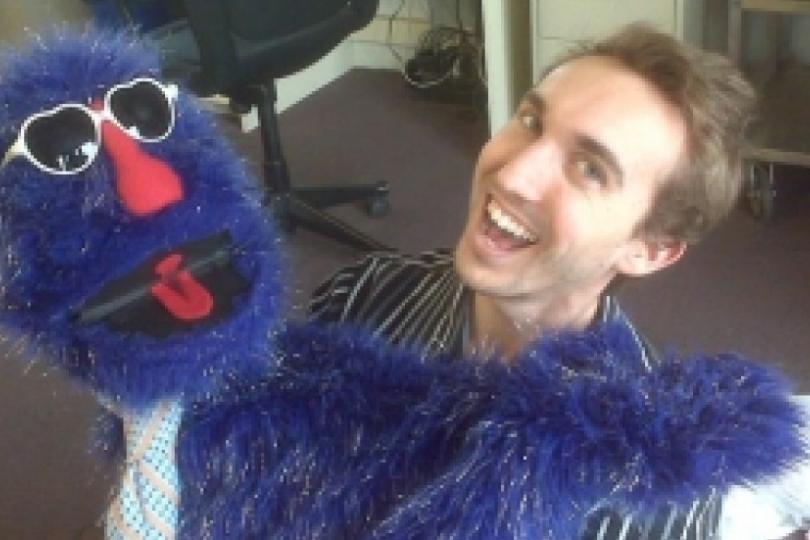What makes a perfect puppet?
Editorial

Here in the Twin Cities we are blessed with an abundance of puppets. How many metro areas can claim a single dedicated puppet theater, let alone the multiple venues we have at our fingertips? Despite its prevalence, puppetry is something of a mysterious medium, even for some seasoned theater people. For instance, without the benefit of a casting call, how does a production go about finding the perfect puppet for the part?
To shed some light on the subject, I called on puppeteer and puppet designer Seth Eberle, creator of Puppets 'n' People. Seth has worked with Bread and Puppet Theater, In the Heart of the Beast Puppet and Mask Theater and Hinterhands Puppetry, among others. He is currently working on a production called Odyssey: The Soles’ Journey Home for ITHOTB's annual PuppetLab series.
How long have you been making puppets?
I have been making puppets for five years.
What made you decide to try your hand at puppet design?
I went to school for theatre, and I started studying and doing a lot of outside work in puppetry and mask performance while still in school because, oddly enough, it seemed more practical than acting. Actors have to be cast in a role before they perform, unless they really want to do a one-man/woman show. However, puppeteers can work whenever it tickles their fancy by making something or putting together a show, be it small or big, without necessarily having to wait for anyone else to motivate them to do so. I guess a lot of puppeteers call it "being able to do everything." Sometimes it is overwhelming, but it is also nice to be able to practice my art on my own terms rather than needing to wait for someone else to decide I am able to play a particular role.
What goes into casting a puppet for a particular role? Do people come to you with a specific request for a design or are you more likely to "freestyle" your creations?
Casting a puppet is sort of complex because it depends on a show's particular process. If a show is working from a script, then a puppet needs to accomplish the tasks that are given to it in the script, so the process of designing the puppet for the part needs to follow those tasks. However, a lot of puppet artists tend to work from a storyboard, which is more like a comic strip. If a show is working from a storyboard, then the puppet artist is generally working toward a more specific visual effect, so casting a puppet becomes a process of what materials and objects will work towards the overall desired effect. If I am working on a show, then I think that I tend toward having a specific task in mind while also responding to what the object being created is telling me it wants to do. If a puppet is really good at a particular movement, then it tends to work its way into performance.
Do you often know what performer is going to be operating one of your puppets when you're making it? How much bearing does that have on the design?
Puppets tend to work best if a performer assists in the creation of the object, I think. When I am making smaller puppets that are disconnected from the body, then I tend to not design a puppet with a particular performer in mind. However, when working on a larger scale – for example, a puppet that creates a huge human figure with the performer inside the body – then the performer needs to be able to carry the armature, so taking the performer into account is very important. When working on a larger scale, it is also great to know if performers have certain movement tricks that could be used to create interesting puppet movement. Puppet and dance seem to have a connection in that they are both movement-focused.
Do your puppets often get recast in different plays? Does that usually require alterations?
I haven't used a puppet from one show and put it into another show yet. Mainly because the shows that I have created have all had drastically different aesthetics, so using a puppet from one show would have seemed jarring to another audience. However, I imagine that as I continue to work in puppetry I will begin to re-use some objects to save time and alter them by painting them or making them fit other performers. That being said, I have saved most of the puppets I have made in order to re-mount productions that I have created in the past.
Have you ever seen a performance where you felt one of your puppets was miscast?
Casting is a funny word to use in puppetry because it calls to mind casting a face or arm for a puppet. For example, I might say, "I sculpted this face for the puppet and created a paper clay cast of it to add to the body." So, as far as visual art goes, sometimes my faces do not turn out when they come off of a mold. They are miscast. I try to alter them and change or use paint to fix the imperfection. It would be nice to have all of the things made come out perfectly, but such is life.
However, as far as the theatrical use of the word, a puppet is made for its part. So, if a puppet is not able to accomplish the task it was intended to in performance, then it would indeed be miscast, but I think that lots of hard work helps alleviate that problem.
Are there any artists you’d cite as key influences on your puppetry?
I feel like I am constantly surrounded by artists who have affected my work, and the list is very long. In college I was heavily influenced by the idea of visual art used for social and community engagement, as practiced by a professor named Michael Strand and a ceramic artist based in Red Lodge named Jill Foote-Hutton. I also was influenced by my theatrical design mentors Rooth Varland and Pavel Dobrusky, a costume designer and scenic designer respectively.
In Minneapolis, I have been so heavily influenced and learned mountains about the form from numerous puppet artists affiliated in various ways with In the Heart of the Beast Puppet and Mask Theatre, including Bart Buch, Alison Heimstead, Soozin Hirschmugl, Stacy Lee King, Anne Sawyer-Aitch, Sandy Spieler and mountains more. For the production I am currently working on, there are four other artists that are simultaneously working on a show in the same space, and they have also had a huge influence on this production. There is a list that should rightly be 50-60 people long here, so perhaps it is difficult to say key artists.
What local puppet-centric productions have impressed you recently?
I absolutely loved the Paper Hat Game conceived by Torry Bend, which was at Open Eye Figure Theater recently. The way that projection interacted with puppets was amazingly well-designed, and the show had a good balance between narrative and stunning visuals.




